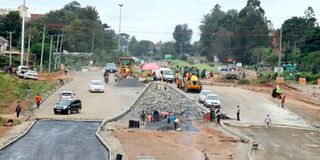State unlocks bonds to finance road projects

The ongoing construction of the bridge near the Mutuine River along the 2.5km Southern Bypass on June 7, 2022.
The State has adopted a new law allowing it to use half of the proceeds of a tax on fuel imports to secure loans for the maintenance, development, and rehabilitation of roads in the country.
The newly signed Finance Act 2022 has changed Section 32A of the Kenya Roads Board Act,1999, allowing the Kenya Roads Board (KRB) to set aside half of fuel tax collections through the Road Maintenance Levy Fund (RMLF) to secure loans through options such as bonds to finance road development projects.
“Section 6 of the Kenya Roads Board Act,1999 is amended in sub-section 2 by deleting paragraph c and replacing it with the following new paragraph – manage the funds and allocate monies from the fund in the following manner; 50 percent of the funds shall be allocated in accordance with paragraph (d) and fifty percent of the fund shall be allocated for purposes of section32A (2)” the Finance Act 2022 reads in part.
Additional allocation
Section 32A of the Kenya Roads Board Act mandates KRB to set aside a portion of the fund for securing additional allocation through options such as bonds.
The changes follow recommendations by the Transport Committee of the National Assembly that the board is allowed to tap the RMLF to help “unlock” the issuance of road bonds.
In 2019, MPs approved legislation for the levy to be used to back infrastructure bonds. Issuance was delayed by the lack of a legal framework that has now been addressed by the Treasury and the Roads ministry in changes to the Finance Act 2022.
Kenya’s road sector presently has an estimated funding gap of Sh590 billion for repairing its run-down network, forcing the State to go for options such as bonds to bridge the deficit.
The State maintains the country’s road network through the KRBF, which is mainly financed through the RMLF currently charged at 18 shillings per litre of petrol and diesel as well as transit tolls.
The board estimates that leveraging half of the RMLF to float bonds would raise Sh150 billion. The collections are projected at Sh84 billion for the year ended June 30.
Besides unlocking the fundraising option through bonds, the changes to Finance Act 2022 mean that road agencies will get more funding thanks to an increment of their share of the RMLF allocation to 50 per cent.
Currently, only 10 per cent of the RMLF goes to development, and the rest for road maintenance—like filling potholes, paint markings, and furniture.
Of the remaining 90 per cent, Kenya Rural Roads Authority has been getting 10 per cent, Kenya National Highways Authority 40 per cent and Kenya Urban Roads Authority 15 per cent.




